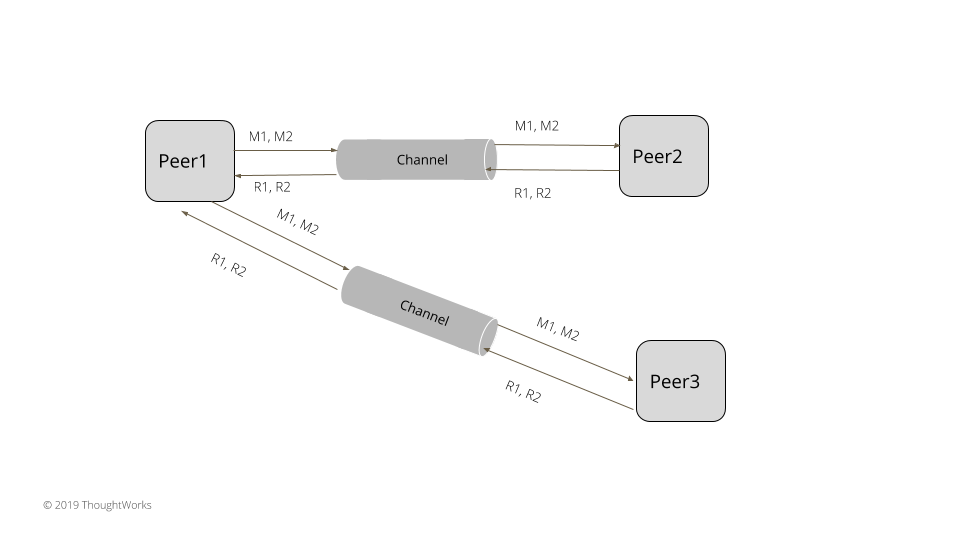单 Socket 通道(Single Socket Channel)
通过一个 Socket 通道连接,维护发送给服务器的请求顺序。
问题
当我们使用 Leader And Followers,对于消息丢失重试机制,我们需要确保消息在 leader 和 followers 的有序性。我们需要在保持低新连接成本的同时做到这一点,以至于打开一个新连接不会增加系统的延时。
解决方案
幸运的是,长时间并广泛使用的 TCP 机制提供了所有这些必要的特征。我们需要确保 followers 和 leader 之间的所有通信都是通过一个 socket 通道来获取我们需要的通信。followers 然后会序列化从 leader 使用一个单更新队列的更新

节点一旦打开连接并连续读取新的请求就从不会关闭。每一个连接节点都会用一个专用线程来读写请求。如果使用的是非阻塞的 io,都不需要每个连接一个线程。
一个简单基于线程的实现:
class SocketHandlerThread…
@Override
public void run() {
try {
//Continues to read/write to the socket connection till it is closed.
while (true) {
handleRequest();
}
} catch (Exception e) {
getLogger().debug(e);
}
}
private void handleRequest() {
RequestOrResponse request = readRequestFrom(clientSocket);
RequestId requestId = RequestId.valueOf(request.getRequestId());
requestConsumer.accept(new Message<>(request, requestId, clientSocket));
}
节点读取请求并提交它们到一个单更新队列中来处理。一个节点处理这个请求,它会向 socket 回写一个响应。
每当节点建立通信时,它就会打开一个 socket 通道连接,用于连接与另一方的所有请求。
class SingleSocketChannel…
public class SingleSocketChannel implements Closeable {
final InetAddressAndPort address;
final int heartbeatIntervalMs;
private Socket clientSocket;
private final OutputStream socketOutputStream;
private final InputStream inputStream;
public SingleSocketChannel(InetAddressAndPort address, int heartbeatIntervalMs) throws IOException {
this.address = address;
this.heartbeatIntervalMs = heartbeatIntervalMs;
clientSocket = new Socket();
clientSocket.connect(new InetSocketAddress(address.getAddress(), address.getPort()), heartbeatIntervalMs);
clientSocket.setSoTimeout(heartbeatIntervalMs * 10); //set socket read timeout to be more than heartbeat.
socketOutputStream = clientSocket.getOutputStream();
inputStream = clientSocket.getInputStream();
}
public synchronized RequestOrResponse blockingSend(RequestOrResponse request) throws IOException {
writeRequest(request);
byte[] responseBytes = readResponse();
return deserialize(responseBytes);
}
private void writeRequest(RequestOrResponse request) throws IOException {
var dataStream = new DataOutputStream(socketOutputStream);
byte[] messageBytes = serialize(request);
dataStream.writeInt(messageBytes.length);
dataStream.write(messageBytes);
}
在连接上设置超时是非常重要的,在出错的场景下,它不会无线等待。我们在 socket 通道上使用心跳检查定时发送请求保持存活。这个超时通常设置为心跳间隔的倍数,来允许网络往返的时间和可能出现的一些延迟。将连接超时保持为心跳间隔的10倍是合理的。
class SocketListener…
private void setReadTimeout(Socket clientSocket) throws SocketException {
clientSocket.setSoTimeout(config.getHeartBeatIntervalMs() * 10);
}
在 socket 通道上发送请求会产生一个行头阻塞(head of line blocking)的问题。为了避免这个,我们可以使用请求管道。
例子
- Zookeeper 使用单个 socket 通道以及每个 follower 一个线程与所有的通信。
- Kafka 在 leader 和 followers 分区之间使用单个 socket 通道,备份信息。
- 参考 Raft 的一致性算法实现,LogCabin 使用单个 Socket 通道在 leader 和 followers 之间通信。
原文连接:https://martinfowler.com/articles/patterns-of-distributed-systems/single-socket-channel.html